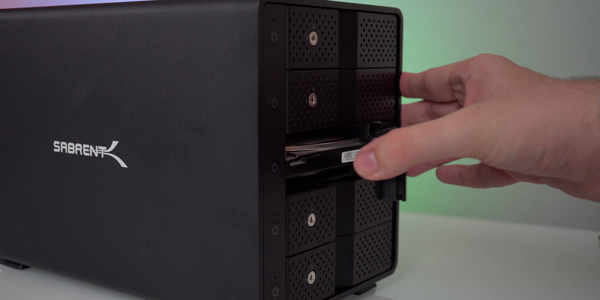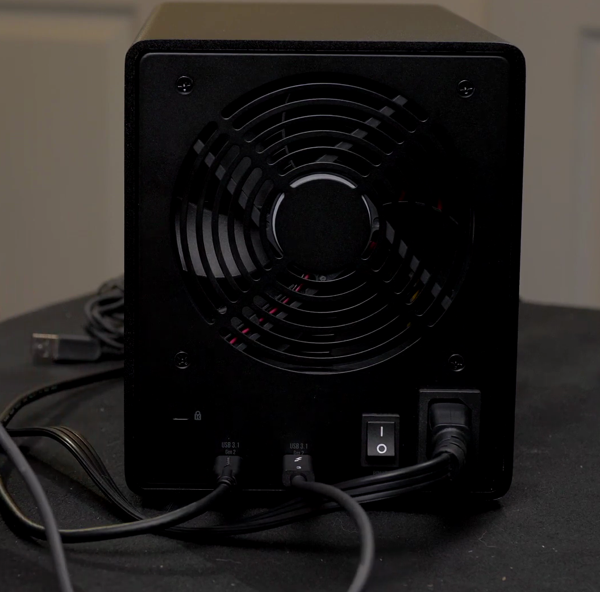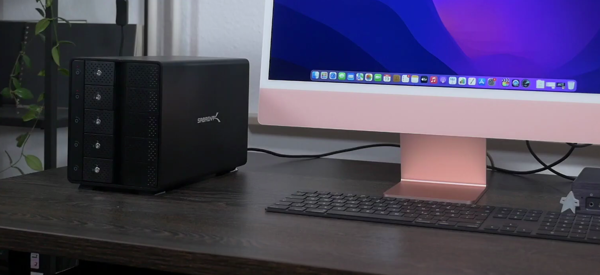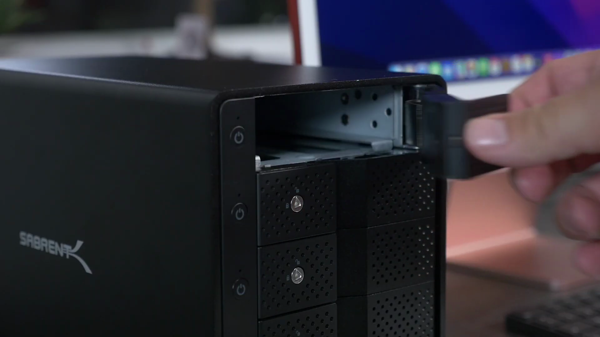Note: As an Amazon Associate I earn from qualifying purchases.
Review: Using the SABRENT 5-Bay USB-C Docking Station (2024)
Introduction
I recently received the SABRENT 5-Bay Docking Station at the office, a device that provides additional storage space with fast data access / transfer speeds. I manages multiple external drives and this device quite simplifies drive management. Below I review its performance, construction, and overall functionality.
Specifications
| Property | Value | Property | Value |
|---|---|---|---|
| Brand | SABRENT | Hardware Interface | USB Type C |
| Product Dimensions | 6.1”L x 4.1”W x 6.3”H |
Photos
Click on photos to enlarge them:
Prices
Check prices of the SABRENT 5-Bay USB-C Docking Station on:
Design and Build Quality
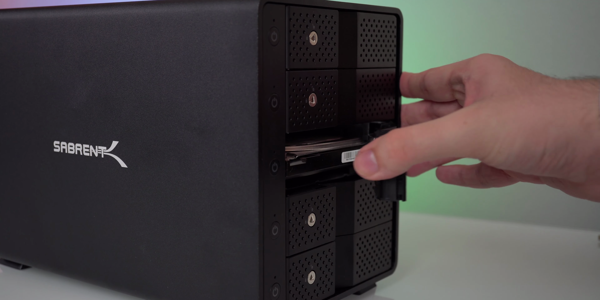
When it comes to design and build quality, the SABRENT 5-Bay Docking Station certainly brings some interesting talking points to the table. Here are some observations:
Materials: It’s housed in plastic which may not feel as premium as a metal enclosure, but it does keep the weight down. The black color scheme is pretty standard and should fit in with most setups.
Form Factor: Its compact size is appreciated, fitting nicely on a desk without taking up too much space.
Build: There is a bit of flex in the plastic, and although this hasn’t impacted functionality, it does leave me wondering about its long-term durability, especially around the SATA connectors.
Magnetic Lid: The magnetic lid design is nifty for quick access, though it’s a double-edged sword as the top can detach too easily if you’re not careful.
Here’s a quick pros and cons list to break down my thoughts:
Pros:
Lightweight and compact
Tool-free drive installation
Hot-swappable bays
Fan included for active cooling
Cons:
Plastic build feels less durable
Magnetic lid may detach unintentionally
Noisy fan
Bright LED lights can be intrusive
In use, the tool-free nature of drive installation really stands out. No need for screws or trays; you simply slide the drive in. It makes the whole process quick and stress-free, which is a huge plus for someone who frequently swaps out drives. However, the oversized slots meant to accommodate various drive sizes don’t always make for a snug fit, so you’ll want to ensure everything is properly aligned to avoid connection issues.
The addition of a built-in fan is something you don’t always find with docking stations, and it’s a nice touch. It does, however, contribute to ambient noise levels. In quieter environments, this could be distracting. Thankfully, the fan can be easily turned off, though doing so can raise concerns about overheating, especially if your drives are working hard.
There’s also something elegantly simple about how everything connects over a single, fast USB-C cable. The included power adapter also alleviates any concerns about power draw from multiple drives, but it does mean extra cabling and the need for an available outlet.
My only real design gripe? The LED lights. They’re useful for monitoring activity and status but are distractingly bright. This isn’t uncommon in consumer electronics, but for folks sensitive to light or who like to keep a darkened workspace, it could be an issue worth considering.
Overall, the design and build quality of the SABRENT 5-Bay Docking Station strike a balance between functionality and convenience, with some minor trade-offs in material choice and fan noise. However, these drawbacks are by no means deal-breakers, and the practical benefits of this docking station do shine through.
Performance and Transfer Speeds

When looking at performance and transfer speeds, the SABRENT 5-Bay Docking Station (DS-5R15) really shines through with its impressive USB 3.2 Gen 2x1 interface, boasting up to 10Gbps transfer rates. This has been a game changer for my workflow. Let’s break it down into a simple list of what stands out:
Speed: Before jumping into any other detail, the foremost aspect that needs attention is the speed. Transferring large files or managing backups quickly is a dream come true with this docking station. I was able to back up gigabytes of data in what felt like no time at all.
Independence of Drives: Each of the five drives can be used independently, which is perfect for multitasking across different projects.
Hot-Swappable and Plug & Play: The ease with which I can switch drives without rebooting my PC adds a layer of convenience hitherto unexperienced.
Reliability: Thanks to the included 12V/3A power adapter, I’ve never faced any power-related issues that could disrupt data transfers.
However, the setup isn’t without its drawbacks. I did observe that under heavy operation, especially when using multiple HDDs, the unit tends to get warm. While the built-in cooling fan is a savvy inclusion to combat this, it also introduces the issue of noise which can be a distraction in quieter settings. Another observation is that initially, the drives did not seem accessible, but post a Windows update, they all came online, hinting at possible compatibility hiccups which could be improved with firmware updates from SABRENT.
The flexibility that this SABRENT Docking Station offers, by essentially adding external hot-swappable bays, can be indispensable. Despite its quirks with the fan noise and possible initial compatibility issues, I’m still impressed with the seamless data transfer experience. For optimal long-term reliability, I would stick to using SSDs and sparingly use HDDs unless necessary, to minimize the reliance on the cooling fan and thus reduce noise levels.
In essence, from the perspective of someone who values data transfer speed and drive management convenience, the SABRENT 5-Bay Docking Station has a solid performance, establishing itself as a utility-driven device rather than just another peripheral. Its ability to handle multiple drives and keep them running cool - even if it’s a bit louder than I would like - makes it a standout choice for storage expansion and data management tasks.
Cooling System Efficiency

In my hands-on experience with the SABRENT 5-Bay Docking Station, I’ve paid particularly close attention to the cooling system. With the potential to load up to five 2.5” drives, it’s imperative that the unit manages heat effectively. Here’s a rundown of the key components and my take on them:
Active Cooling: The presence of an 80mm built-in fan is a strategic choice for active cooling. The fan is key for maintaining drive health, especially during heavy usage.
Switchable Fan Control: I appreciate the flexibility of being able to toggle the fan on and off to suit my noise preference at any given time.
Heat Management: With all bays occupied, the drives do get warm, but the active cooling system keeps temperatures in check.
Noise Level: While it’s not the quietest fan I’ve encountered, its hum is within reasonable levels given the cooling it provides.
I’ve noticed that the fan, when active, proficiently prevents the drives from overheating, even during extensive file transfers or backup operations. Although the fan noise is discernible, it’s a trade-off for keeping those drives cool. On quieter days, the ability to switch the fan off is a welcome feature, though I’ve made sure to keep an eye on drive temperatures when doing so.
One clear downside is the fan’s noise level. In a silent room, it can be quite noticeable. For users who are sensitive to sound or work in a studio environment, this could be a point of contention. This makes me wonder about potential for a future model with variable speed control or even a quieter, more sophisticated cooling system.
Another aspect worth noting is that the fan needs to be manually switched on after powering up the device. This isn’t a huge issue, but an auto-on feature for the fan based on temperature checks could be a convenient addition to future iterations of the product.
My overall opinion leans toward the positive side. The cooling system is effective and essential for a multi-drive setup and the pros undoubtedly outweigh the momentary inconvenience of fan noise. This along with the plug-and-play convenience and the USB 3.2 Gen 2x1 connectivity, makes the SABRENT 5-Bay Docking Station a productive addition to my workflow.
In terms of further reading on cooling efficiency for electronic devices, one could check the IEEE Xplore Digital Library or research papers from university engineering departments which often delve into the topic of thermal management.
The balance between efficiency and acoustics of the cooling system is crucial and SABRENT seems to have struck an admirable one albeit with room for enhancements. The DS-5R15 offers a practical solution for external storage needs, and while it could benefit from a few tweaks, it remains one that I’m happy to have on my desk.
Usability and Functionality

When it comes to usability and functionality, the SABRENT 5-Bay Docking Station certainly adds a new layer of convenience to my storage management. Navigating through its features from a personal perspective, I appreciate the practicality of having tool-free, hot-swappable bays which allow me to switch between drives without much fuss. The USB-C connectivity is another highlight, offering speedy file transfers that make a noticeable difference when handling large volumes of data.
However, using this docking station isn’t without its challenges. The fan noise, for example, has been an occasional source of irritation, prompting me to either switch it off or relocate the docking station to reduce disturbance. Additionally, the need to be cautious when moving the unit, given the magnetically attached top, adds a layer of caution to its handling.
Here’s a quick rundown of the main points I’ve gathered:
Pros:
Hot-swappable, tool-free design enhances user experience.
Fast USB-C interface minimizes transfer times for large files.
Compatibility with Windows, macOS, and Linux increases versatility.
Active cooling with a built-in fan – a safeguard against drive overheating.
Cons:
The fan is loud, which can be distracting in quiet environments.
Initial setup can be finicky with drive alignment taking some effort.
The unit’s lightweight construction raises concerns about durability.
I had concerns about the sturdiness of the build, questioning its longevity if frequently moved or reconfigured with different drives. Despite these drawbacks, the function of the docking station, including its ability to accommodate various drive heights, is a strong point in favor of flexibility.
From a practical standpoint, the docking station has simplified my approach to expanding storage. It feels satisfying to not worry about internal SATA port availability or cumbersome enclosure assemblies. Its plug-and-play feature is also a time-saver, contributing to the overall positive aspects of the docking station.
In summary, the SABRENT 5-Bay Docking Station has found its place in my setup, despite initial hiccups and ongoing considerations regarding fan noise and build quality. The convenience it delivers by enabling easy access to multiple drives and fast data transfers balances out the negatives. When measured against my everyday practical needs, it proves to be a valuable asset in managing and expanding storage capabilities.
